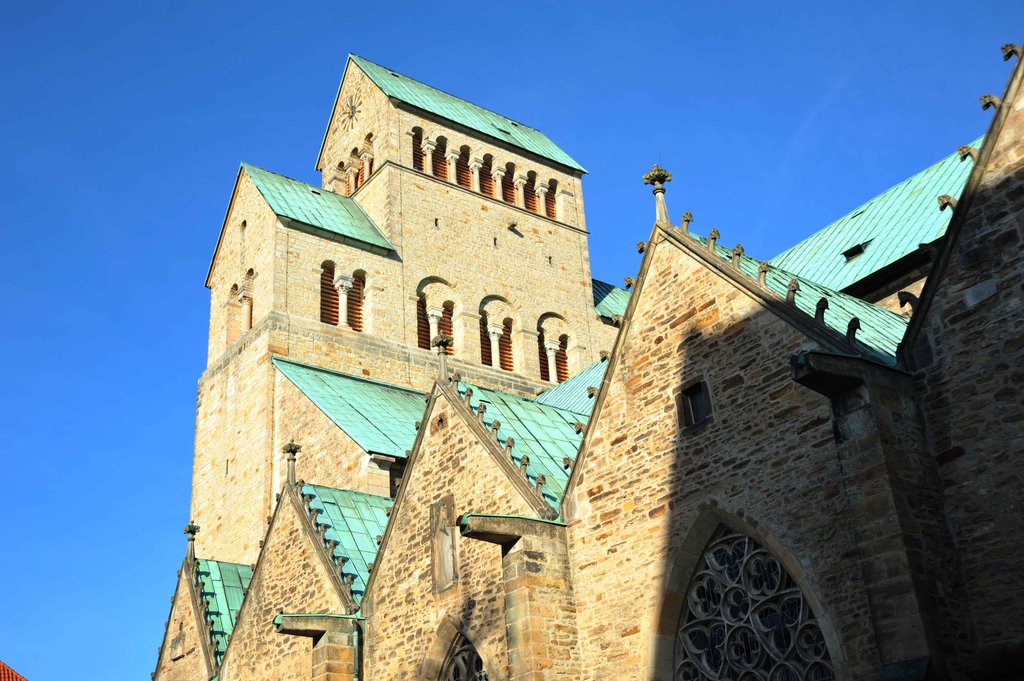The Hildesheim Cathedral
The Hildesheim Cathedral of the Assumption of Mary is one of the oldest cathedrals in Germany. Its architectural history goes back to the 11th century, but the history of its origin reaches as far back as the year 815.
Klick the image to get more information about the cathedral
According to legend, it was a miracle through a relic that prompted Emperor Ludwig the Pious to build a Lady Chapel on this site. The chapel became the foundation for the first cathedral built in the area, constructed in 872 by Bishop Altfrid, on the site of what is today the Cathedral courtyard. Around 1015, under Bishop Bernward, the cathedral was richly decorated with works of art. To house the bronze "Bernward door", the western crypt was remodelled and a new main west portal was erected. Around 1035 Bishop Godehard ordered the demolition of the western end of the cathedral and built a new westwork with an atrium and a bell tower. In 1046 however, the cathedral was extensively damaged by fire. Two years earlier, Bishop Azelin had begun to build a large new building to the west of the cathedral. But the new building had massive construction defects. Azelin’s successor, Bishop Hezilo, therefore abandoned the project and instead ordered the construction of a new cathedral on the foundations of the earlier Altfrid Cathedral. The new cathedral was inaugurated in 1061.
Over the centuries, the cathedral was repeatedly extended or structurally changed. The building of the Laurentius Chapel was put in place in 1079 under Bishop Hezilo (who also gave the cathedral its famous ‘Hezilo Chandelier’). In 1321, Bishop Otto of Wohldenberg built the Chapel of St. Anne in the middle of the cloister. Significant changes took place from 1841 to 1850, during which time the demolition of the ‘Gotthard-westwork’ and the side chapels ensued, and a new twin-tower façade, modelled after St. Godehard in Hildesheim, was added.
Towards the end of World War II, on 22 March 1945, the cathedral was hit by bombs. The north side, the transept and the east choir collapsed. The roofs and West towers were burned out. Following the end of the war, additional parts of the wall collapsed. However, the war was followed by a second miracle: the thousand-year-old rosebush that had wound itself around the cathedral apse over the centuries had also gone up in flames during the bombings. But eight weeks after the complete destruction of the Hildesheim Cathedral, 25 new shoots sprouted from its debris-covered roots. To this day the thousand-year rose entwines the Hildesheim Cathedral, and is one of the city’s attractions. According to tradition, it marks the place of origin of the diocese and city of Hildesheim.
The reconstruction of the cathedral was undertaken in the 1950’s. The builders stayed true to the original and the cathedral was rebuilt on the foundations of Hezilo Cathedral. On March 27 1960, the Cathedral was re-consecrated by Bishop Heinrich Maria Janssen.
In 1985, the Hildesheim Cathedral and its treasures, together with the nearby St. Michael's Church, were added to the list of UNESCO World Heritage sites.
50 years after the reconstruction, additional restoration became necessary since no work had been carried out on the Cathedral over the decades, with the exception of a small plaster restoration in the 1970’s. Therefore, on 10 January 2010, the cathedral was closed for four and a half years, to facilitate extensive renovations. The cathedral was officially reopened by Bishop Norbert Trelle on August 15, 2014.


